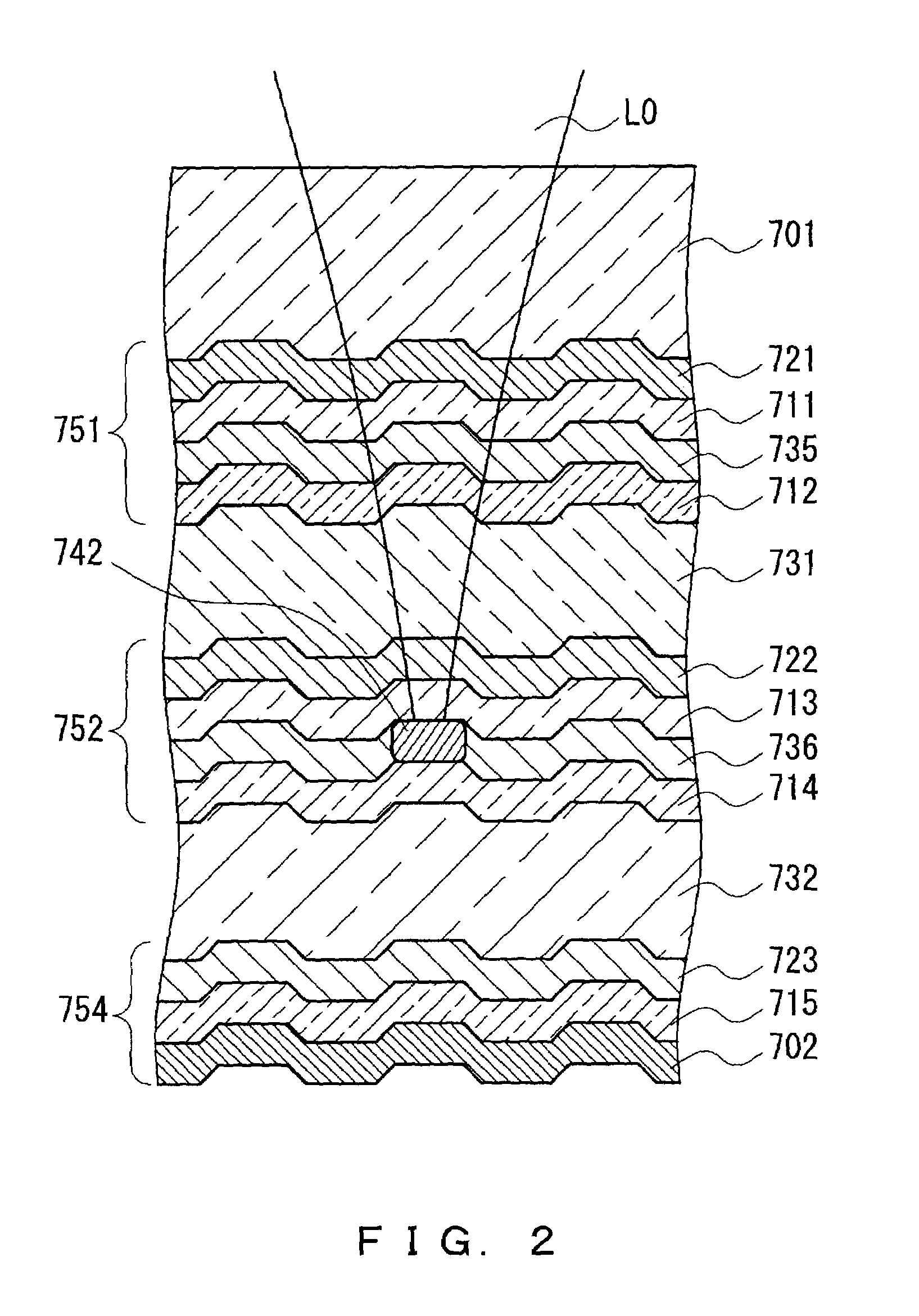Optical record medium, optical information processing apparatus, and optical recording/reproducing method
- Summary
- Abstract
- Description
- Claims
- Application Information
AI Technical Summary
Benefits of technology
Problems solved by technology
Method used
Image
Examples
embodiment 1
[0030]FIG. 1 is a cross-sectional view showing a configuration of an optical recording medium of Embodiment 1. This optical recording medium is a multilayer recording medium in which a first recording layer 751, a second recording layer 752 and a final recording layer 754 are formed in this order from a light (L0) incident side. Separation films 731 and 732 are provided between the respective recording layers.
[0031]The first recording layer 751 and the second recording layer 752 have the same layer configuration. In the layer configuration, a recording film 721 (722), a dielectric film 711 (713) and a reflection control film (variable reflective film) 735 (736), and a dielectric film 712 (714) are provided in this order from the light (L0) incident side.
[0032]Further, the final recording layer 754 is provided so that the separation film 732 is interposed between the final recording layer 754 and the second recording layer 752. The final recording layer 754 is composed of a recording...
embodiment 2
[0043]An optical recording medium of Embodiment 2 is obtained by applying a configuration shown in FIG. 6 to the recording layers 751 and 752 other than the final recording layer 754 of the optical recording medium of Embodiment 1. FIG. 6 shows that information is recorded / reproduced with respect to the first recording layer 751.
[0044]In FIG. 6, reference numerals 711 and 712 denote dielectric films, and 735 denotes a reflection control film. These films are the same as those in Embodiment 1. A recording film 721 is substantially transparent to light L0, and records information based on the difference in a refractive index. A heat absorption and generation film 746 is made of a material semi-transparent to the light L0. For example, in the case where the light L0 is laser light with a wavelength of about 650 mm, a thin film of amorphous Si can be used as the heat absorption and generation film 746. The light L0 is absorbed by the heat absorption and generation film 746 to generate h...
embodiment 3
[0049]An optical recording medium of Embodiment 3 is obtained by applying a configuration shown in FIG. 7 to the recording layers 751 and 752 other than the final recording layer 754 of the optical recording medium of Embodiment 1. FIG. 7 shows that information is recorded / reproduced with respect to the first recording layer 751.
[0050]In FIG. 7, reference numerals 711 and 712 denote dielectric films. Reference numeral 735 denotes a reflection control film. These films are the same as those in Embodiment 1. A recording film 721 is substantially transparent to light L1 with a wavelength λ1 and light L2 with a wavelength λ2, and records information by utilizing the variation in refractive index with heat. A wavelength-selection and absorption film 743 is made of a material that is semi-transparent to the light L2, and is transparent to the light L1. For example, when the wavelength λ1 of the light L1 is about 430 nm and the wavelength λ2 of the light L2 is about 650 nm, the wavelength-...
PUM
 Login to View More
Login to View More Abstract
Description
Claims
Application Information
 Login to View More
Login to View More - R&D
- Intellectual Property
- Life Sciences
- Materials
- Tech Scout
- Unparalleled Data Quality
- Higher Quality Content
- 60% Fewer Hallucinations
Browse by: Latest US Patents, China's latest patents, Technical Efficacy Thesaurus, Application Domain, Technology Topic, Popular Technical Reports.
© 2025 PatSnap. All rights reserved.Legal|Privacy policy|Modern Slavery Act Transparency Statement|Sitemap|About US| Contact US: help@patsnap.com



